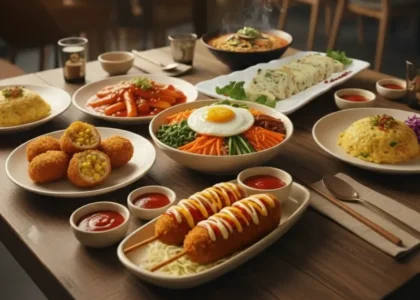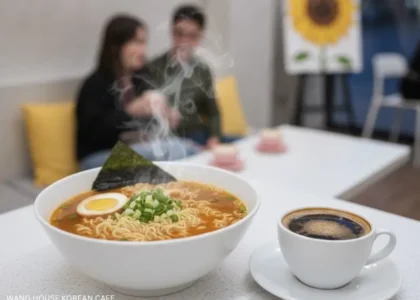K-food boasts a rich and storied history, deeply woven into the nation’s cultural fabric. For centuries, beloved dishes like Kimchi, Bibimbap, and street food classics such as Tteokbokki have been celebrated for their unique flavors. These dishes are also recognized for their health benefits and rich traditions, making them a cherished part of Korean cuisine. Packed with fresh vegetables, fermented ingredients, and balanced nutrition, traditional Korean food promotes wellness and vitality. Today, as we step into the 21st century, a remarkable culinary transformation is taking place. Both chefs and home cooks are creatively reinventing traditional recipes, blending flavors and styles to suit modern palates and preferences.
They emphasize wholesome ingredients. In this blog, we will dive into the evolution of modern Korean cuisine. And explore how Korean ramen noodles are becoming a trendy global sensation. We will also examine how street food is gaining gourmet status while maintaining a focus on health and nutrition.
K-Food: The Fusion of Tradition and Innovation

One of the most exciting trends in modern K-food is the blend of tradition and innovation. Korean chefs are experimenting with traditional recipes, infusing them with global flavors and modern cooking techniques to appeal to today’s health-conscious food lovers. The iconic Kimchi, a spicy fermented vegetable dish, is known for its probiotic benefits and is now used in global recipes. It adds a unique spicy twist to favorites like burgers and pizzas while promoting gut health. This fusion of traditional K-food with global influences has created new culinary experiences that focus on nutrition. In upscale restaurants worldwide, Korean BBQ exemplifies this blend of tradition and innovation. Traditionally, Korean BBQ involves grilling marinated meats at the table, served with a variety of nutritious side dishes called Banchan. Today, this interactive dining experience is being elevated with new flavors and presentation styles, turning it into a fine dining affair. Popular K-food restaurants near me are offering Korean BBQ with modern twists, such as truffle-infused marinades or premium cuts of meat, enhancing the traditional experience while ensuring it remains flavorful and wholesome.
Reimagining K-food: The Rise of Trendy Ramen

Perhaps one of the most significant evolutions in Korean cuisine is the transformation of ramen noodles from a quick and budget-friendly meal into a gourmet sensation that prioritizes health. Traditionally seen as instant ramen, today’s Korean ramen has evolved into a sought-after dish at restaurants around the world. Popular varieties like Spicy Veg Ramen, Kimchi Ramen, and Hot and Spicy Chicken Ramen have captured global attention for their flavorful and nutritious profiles.
These elevated ramen dishes feature slow-cooked, nutrient-rich broths infused with fresh vegetables, eggs, and tofu. They are an excellent choice for those seeking wholesome vegetarian Korean food. At Wang House – A Korean Cafe in India, ramen is celebrated for its authentic taste and health-conscious ingredients. High-quality, fresh produce and creative additions like cheese or truffle oil transform Korean ramen into a gourmet experience.
This experience satisfies both the palate and nutritional needs. As Korean ramen brands expand, food lovers worldwide are eager to explore the best ramen flavors. These flavors strike the perfect balance between spice, umami, and health.
Vegan and Plant-Based Korean Food: A Growing Trend
The rise of vegan and plant-based diets has significantly influenced the evolution of modern Korean cuisine, leading to healthier alternatives that promote well-being. Traditionally, many Korean dishes like Kimchi and Bulgogi are meat or fish-based, but today, there are delicious vegan alternatives that cater to a growing number of health-conscious and environmentally mindful eaters. Vegan Kimchi, crafted without fish sauce or shrimp, is becoming a popular option for those seeking flavorful and nutritious vegan Korean food.
Other plant-based favorites, such as vegetarian gimbap and tofu Bibimbap, are gaining attention both in Korea and around the world for their wholesome ingredients and vibrant flavors. Similarly, vegetarian ramen noodles, prepared with nutrient-rich vegetable-based broths like miso or soy, offer a healthy and satisfying meal. With access to the best Korean noodles in India and other countries, enjoying plant-based versions of classic Korean dishes is now easier than ever, allowing everyone to indulge in the rich flavors of Korean cuisine while maintaining a focus on health and sustainability.
Street Food Meets Fine Dining
A noticeable trend in modern Korean cuisine is the transformation of street food into fine dining while emphasizing health benefits. Traditional Korean street food such as Tteokbokki (spicy rice cakes), Hotteok (sweet pancakes), and Korean corn dogs—once popular in Seoul’s bustling markets—are now being served in upscale restaurants, presented with gourmet flair and a focus on nutritious ingredients.
At Wang House in Delhi-NCR and Kerala, Korean street food is reimagined to offer a more refined dining experience that also prioritizes health. For example, Mandu (Korean dumplings) are filled with wholesome ingredients like truffle and fresh vegetables, while Korokke (potato croquettes) are served with inventive dipping sauces made from healthier options. These gourmet takes on traditional Korean street food blend nostalgia with modern sophistication, offering diners an elevated culinary experience that nourishes both body and soul.
The Global Influence on Korean Cuisine

As Korean cuisine continues to evolve, it is becoming increasingly globalized, attracting attention for both its flavors and health benefits. K-pop and Korean dramas have significantly introduced Korean food to international audiences. Fans are eager to try dishes enjoyed by stars. Korean fried chicken has become a global sensation, often paired with local sauces and spices in different countries. It offers a healthier alternative through lighter preparation methods and high-quality ingredients.
Dishes like Bibimbap are being adapted with local ingredients, such as avocado in California or black beans in Mexico. These adaptations enhance their nutritional profiles and make the dishes more accessible. They allow health-conscious consumers to enjoy vibrant flavors of Korean cuisine while incorporating nutrient-dense components. This fusion of tradition and local ingredients makes Korean food a delicious and healthful option for people worldwide.
Korean Desserts and Beverages: A Sweet Evolution

Another exciting aspect of modern Korean cuisine is the reinvention of Korean desserts and beverages. Traditionally, desserts like Bingsu (shaved ice with sweet toppings) and Hotteok (sweet pancakes) were enjoyed as simple street snacks. Today, these desserts are being reinterpreted and served in elegant restaurants, often with gourmet twists like exotic fruits, artisanal syrups, or unique presentations. Similarly, Korean beverages such as iced lattes and traditional teas are gaining popularity globally. The rise of Korean cafes offering these drinks has contributed to their growing appeal. Cafes like Wang House in India are introducing these beverages to new audiences. Whether you’re craving a refreshing iced latte or traditional Korean herbal tea, modern Korean cafes serve unique drinks. These drinks reflect the evolving Korean food culture.
The Role of “K-Food” in the Modern Korean Culinary Landscape

The term K-food has become synonymous with the global popularity of Korean cuisine, driven by K-pop and Korean media. K-food encompasses traditional dishes like Bibimbap and Kimchi, known for their health benefits, to trendy global favorites. These include Korean ramen and fried chicken. As K-food continues to grow in popularity, restaurants like Wang House Korean Cafe play a crucial role. They introduce the world to authentic yet innovative versions of Korean street food. And noodles, emphasize fresh, high-quality ingredients that promote wellness.
By offering healthier adaptations of beloved classics, these establishments cater to the growing demand for nutritious dining options. Incorporating plant-based ingredients and nutrient-rich broths in ramen enhances the health profile of these dishes. Creating lighter versions of fried chicken also contributes to this goal. This fusion of tradition and modern dietary preferences helps K-Food gain international acclaim. It establishes K-Food as a delicious and health-conscious choice for food lovers worldwide.
Conclusion
The evolution of modern Korean cuisine reflects the creativity, adaptability, and global influence of chefs. Food enthusiasts worldwide, particularly in promoting health-conscious dining options. Traditional dishes like Korean BBQ, Kimchi, and ramen are being reimagined, blending innovation and tradition in exciting and nutritious ways. From trendy Korean ramen noodles featuring wholesome ingredients to plant-based options. Gourmet street food, the modern Korean culinary scene offers something for everyone seeking both flavor and health.
So whether you’re searching for the best Korean restaurant near you or looking to try the best Korean noodles in India. There’s a world of bold flavors and creative culinary experiences waiting for you. Dive into the evolving world of K-Food and enjoy the delicious fusion of tradition and innovation while prioritizing your well-being!







I appreciate, cause I found just what I was looking for. You have ended my 4 day long hunt! God Bless you man. Have a great day. Bye
Fantastic job covering this topic in such depth! I can’t wait to implement some of these ideas. This blog stands out among others in this niche. I appreciate the detailed information shared here. I enjoyed reading this and learned something new. I’m bookmarking this for future reference. This blogpost answered a lot of questions I had.